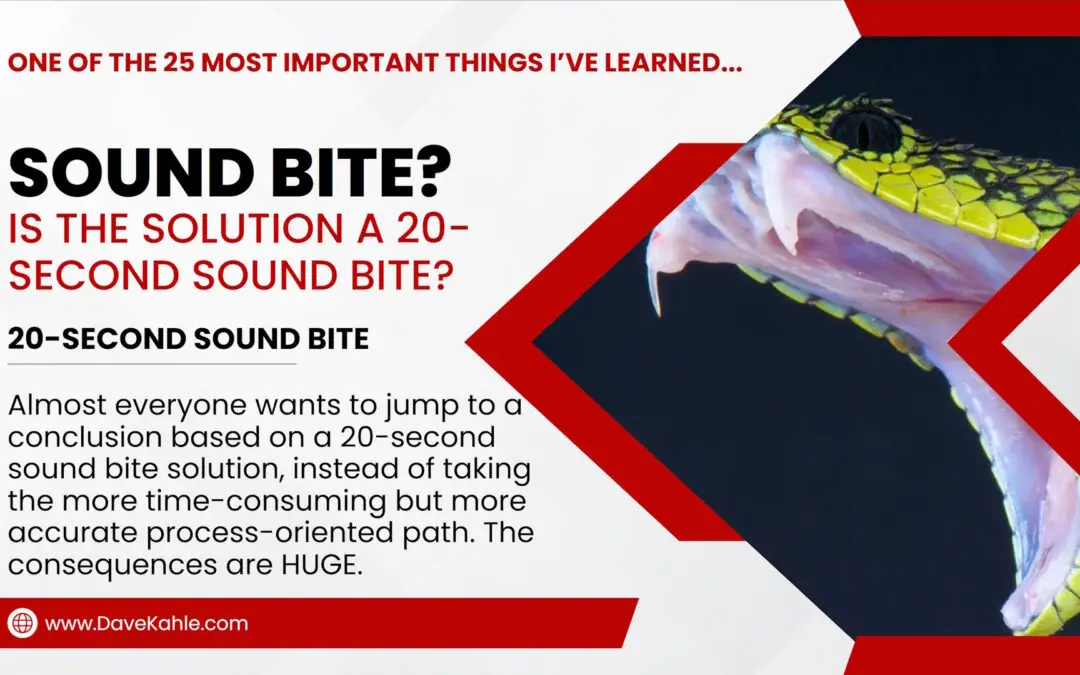Some time ago, one of my clients challenged me to record the 20 most important lessons I’ve learned. After a great deal of reflection, I eventually came up with 25. This is one.
Everyone wants a simple quick solution.
Few value a thoughtful solution ,and that’s to their detriment.”
When confronted with a serious problem, almost everyone wants to jump to a conclusion based on a 20-second sound bite solution, instead of taking the more time-consuming but more accurate process-oriented path.
Granted, my sample is skewered. I work with salespeople, sales managers, sales executives and small business owners. It may be that this observation applies only to that group, but I suspect that it is a universal trait, common to people of every profession and situation in life.
Here’s an example of how this principle works. I’m often approached by sales leaders and small business owners who are uncomfortable with the compensation plan for their salespeople. They will often propose a solution and ask my thoughts. So, they go from a realization of the problem to a potential solution. A simple graph looks like this:

While that might work some of the time, generally a quick solution to a complex problem is almost always going to spin off additional problems. It may allow only a partial answer, or it may miss the mark totally. A quick fix today often leads to more problems down the road a bit. Unfortunately, most people who engage in the 20-second sound bite solution are not even aware that there is a better way. Some are even proud of their habit of jumping to conclusions.
A far better approach to the problem would be to use a process that takes all the variables into account and births a compensation plan that was fully researched and vetted. It takes longer, but the end result will be far superior.
Here’s another example. I am often approached by salespeople who tell me about a situation and ask for a solution. They have made a big proposal in one of their customer accounts, for example, and can’t seem to get any resolution. “What can I do?” they will ask in varying ways.
My response is always to question the process that led up to the situation.
* “Have you identified the key decision makers?”
* “Have you created trusting relationships with them?”
* “Have you completely identified the customer’s needs and interests? “
* “Have you uncovered any concerns from their side?”
Almost always I am answered with some “no’s”. In sales, as in most other human endeavors, you can’t expect a satisfactory conclusion unless you’ve done the necessary work. Just like most other people, the salesperson at my side found an opportunity and jumped right to a solution without doing the necessary leg work that the process requires. As a result, he’s stuck at a dead end.
I just finished a module in our Sales Leader’s Excellence and Influence course. The module dealt with hiring new salespeople. My recommendation: Create a process and stick to the process. When you shortcut the process to jump to a conclusion, you are much more likely to make a costly hiring mistake.

The jump to a conclusion person is far more likely to propose a solution which manifests his/her bias and beliefs that may or may not be applicable to this situation. In my sales force compensation example, the soundbite person may have had a bad experience with a pay plan years ago, and that prejudiced him to a bias toward certain pay plan characteristics. However, if you use a process rather than a jump to a conclusion, the process can be counted on to ferret out and eliminate the prejudice in the final product.
Without a process to protect himself from himself, the manager hiring a salesperson is much more likely to let his/her bias influence an emotional reaction toward the prospective salesperson.
The power truly is in the process. Just as a road trip is mostly about the journey and less about the destination; just as goal setting is less about the goals and more about the self-discovery and prioritization that occurs within the process; so too almost every important and sophisticated task is much better served by adherence to a process than it is jumping to the end.
A well-designed process will consistently and predictably produce far greater results than a leap to the end solution. And it spins off some unanticipated benefits. It almost always creates greater knowledge and awareness on the part of the processors. Almost every time we’ve gone through the process to create a better sales compensation plan, for example, the principles have learned something about the sales force that was new to them. When we create a sales system based on the process a typical customer goes through to come to a decision, the CEOs invariably come away with a greater understanding of salient parts of their business.
Greater confidence comes with the process approach. You know that you’ve done it right, crossed all the t’s and dotted all the I’s and you are confident, therefore, in the end result.
Your time is much better spent journeying through a well-designed process to come to a solid, defendable solution, than it is to propose an immediate solution, and then find yourself redoing it again later, or dealing with the unforeseen consequences of a rash solution.
It is not unusual, when walking through a process, to uncover additional opportunities that the 20-second sound bite guys never uncovered.
The ramifications of sound-bite decision making are larger than anyone suspects. That’s why I think it so important (one of my 25 most important lessons) to note that “Everyone wants a simple quick solution. Few value a thoughtful solution ,and that’s to their detriment.”
Related Resources



